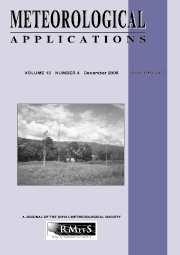Article contents
Detection of hail by means of polarimetric radar data and hailpads: results from four storms
Published online by Cambridge University Press: 21 November 2000
Abstract
Hailfall is one of the most dangerous and damaging phenomena associatedwith severe thunderstorms. Its remote identification is still underinvestigation, especially by means of polarimetric radar data. The need touse polarimetric measurements is a limit to operational implementation ofthe techniques developed up till now. The routine sampling of radar allowsthe computation of the differential hail signal HDR (Aydin et al., 1986)every 15 minutes. The assessment of the HDR is performed by comparison withthe ground truth from a hailpad network. The spatial resolution of thisnetwork is quite coarse (one pad per 16 km2) for the collection of all thehail shafts, as they generally have a small horizontal extent and are shortlived. Such bounds have been considered in the analysis of four largehailfalls recorded in 1997. This study reveals also the limitation on radarhail detection arising from the frequent occurrence of strong differentialattenuation. Nevertheless, to identify regions where a sharp rain-hailtransition occurs, polarimetric measurements work much better thanalgorithms based only on horizontal reflectivity. Results show that use ofHDR gives a high probability of correct hail detection as well as anacceptable number of false alarms.
Information
- Type
- Research Article
- Information
- Copyright
- © 2000 Cambridge University Press
- 6
- Cited by

